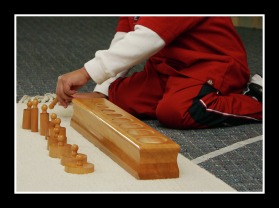Sensorial

Self-correction leads the child to concentrate his attention upon the differences of dimensions, and to compare the various pieces. It is in just this comparison that the psycho-sensory exercise lies.
There is, therefore, no question here of teaching the child the knowledge of the dimensions, through the medium of these pieces. Neither is it our aim that the child shall know how to use, without an error, the material presented to him thus performing the exercises well.
That would place our material on the same basis as many others, for example that of Froebel, and would require again the active work of the teacher, who usies herself furnishing knowledge, and making haste to correct every error in order that the child may learn the use of the objects.
Here instead it is the work of the child, the auto-correction, the auto-education which acts, for the teacher must not interfere in the slightest way. No teacher can furnish the child with the agility which he acquires through gymnastic exercises: it is necessary that the pupil perfect himself through his own efforts. It is very much the same with the education of the senses.
-Maria Montessori
There is, therefore, no question here of teaching the child the knowledge of the dimensions, through the medium of these pieces. Neither is it our aim that the child shall know how to use, without an error, the material presented to him thus performing the exercises well.
That would place our material on the same basis as many others, for example that of Froebel, and would require again the active work of the teacher, who usies herself furnishing knowledge, and making haste to correct every error in order that the child may learn the use of the objects.
Here instead it is the work of the child, the auto-correction, the auto-education which acts, for the teacher must not interfere in the slightest way. No teacher can furnish the child with the agility which he acquires through gymnastic exercises: it is necessary that the pupil perfect himself through his own efforts. It is very much the same with the education of the senses.
-Maria Montessori
A thorough introduction to the Montessori sensorial theory and activities can be found on the AMI Primary Guide page on Sensorial. The following videos show first an overview of the sensorial curriculum, then demonstrations of the presentation of two sensorial activities, the pink tower, and the trinomial cube.
- It is said that context helps learning and memory. Why then does Montessori isolate education of the senses? Is this consistent with knowledge of cognitive neuroscience?
